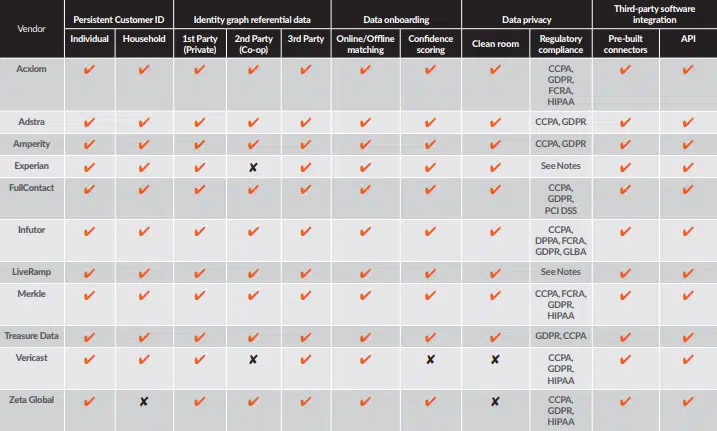An identity resolution platform can be a key tool to enable brand marketers to understand with confidence who their customers are and how to comply with the increasing patchwork of consumer privacy regulations. But deciding whether your company needs an enterprise-level identity resolution platform calls for the same steps involved in any software adoption, starting with a comprehensive self-assessment of your organization’s business needs, staff capabilities, management support and financial resources.
Use the following questions as a guideline:
Does our customer data reside in disconnected silos throughout the organization?
Organizational silos between departments such as sales, marketing, procurement or customer support increase the risk that your customer’s experience with the brand is not as targeted or consistent as it should be. An identity resolution platform may help connect these disparate systems to provide a more insightful view of customers.
Do we have customer knowledge gaps that could be filled with trusted second- and third-party data?
First-party data is the foundation of your brand’s relationship with customers. Yet identity graphs can be a valuable source of demographic, location, financial and other anonymized second- and third-party data that can fill gaps in customer insights. As data collection and matching techniques improve, along with access to cooperative data sources, creating a 360-degree view of customers through identity resolution platforms may make sense.
Are we in compliance with CCPA, GDPR and other data privacy regulations?
Consumer data breaches and evidence of misuse continue to make news headlines. As a result, data privacy regulations are on the upswing. Is your organization’s data governance practices in compliance with the EU’s GDPR or the CCPA? Collecting and using consumer data is a powerful marketing tool, but also escalates the risk of damaging your brand and incurring legal consequences.
Can we successfully integrate our existing customer data systems with an identity resolution platform?
Marketers continue to rely on larger technology stacks to collect, analyze and execute customer-centric marketing strategies. But can your various martech and ad tech systems “talk” to each other? Perhaps your organization can benefit from an identity resolution platform that can incorporate identifiers and profiles between and within these systems for consistency and accuracy.
Does our C-suite support identity resolution initiatives?
A Forrester study found that the majority of C-level executives overrate their marketing organization’s customer identity accuracy and persistence. A lack of executive buy-in can lead to inadequate budgeting, campaign measurement and performance, and broken customer experiences. It is critical, therefore, to secure C-suite support for identity resolution initiatives across the organization.

Explore platform capabilities from vendors like Acxiom, Experian, Infutor, Merkle and more in the full MarTech Intelligence Report on identity resolution platforms.
How would we use identity resolution?
There are multiple marketing use cases for identity resolution, from complying with data privacy regulations to developing more accurate lookalike audiences to improved marketing segmentation and targeting. Identifying the specific use cases that would most benefit your organization is essential to establishing and prioritizing the capabilities you’ll need in an identity resolution platform.
What KPIs do we want to measure and what decisions will we be making based on the data?
As with any technology investment, it is critical to measure the impact of the identity resolution platform on your marketing ROI. Resolving customer identities should create new cross-sell and upsell opportunities because your marketing team will know more about your customers. Although KPIs will vary by organization or industry, you should be able to measure incremental lift in metrics such as average order value, average revenue per user, basket size, response rates or customer retention.
What is the total cost of ownership?
The majority of enterprise identity resolution platforms use on-demand pricing, meaning customers pay a monthly subscription price that will vary by usage. Pricing is typically based on the number of data records or customer profiles under management or the number of matches or API calls. Some also have add-on customer support options.
Identity resolution platforms: A snapshot
What it is. Identity resolution is the science of connecting the growing volume of consumer identifiers to one individual as he or she interacts across channels and devices.
What the tools do. Identity resolution technology connects those identifiers to one individual. It draws this valuable data from the various channels and devices customers interact with, such as connected speakers, home management solutions, smart TVs, and wearable devices. It’s an important tool as the number of devices connected to IP networks is expected to climb to more than three times the global population by 2023, according to the Cisco Annual Internet Report.
Why it’s hot now. More people expect relevant brand experiences across each stage of their buying journeys. One-size-fits-all marketing doesn’t work; buyers know what information sellers should have and how they should use it. Also, inaccurate targeting wastes campaign spending and fails to generate results.
This is why investment in identity resolution programs is growing among brand marketers. These technologies also ensure their activities stay in line with privacy regulations.
Why we care. The most successful digital marketing strategies rely on knowing your potential customer. Knowing what they’re interested in, what they’ve purchased before — even what demographic group they belong to — is essential.
Read next: What is identity resolution and how are platforms adapting to privacy changes?
























































![Key Metrics for Social Media Marketing [Infographic] Key Metrics for Social Media Marketing [Infographic]](https://www.socialmediatoday.com/imgproxy/nP1lliSbrTbUmhFV6RdAz9qJZFvsstq3IG6orLUMMls/g:ce/rs:fit:770:435/bG9jYWw6Ly8vZGl2ZWltYWdlL3NvY2lhbF9tZWRpYV9yb2lfaW5vZ3JhcGhpYzIucG5n.webp)






-1.jpg)












